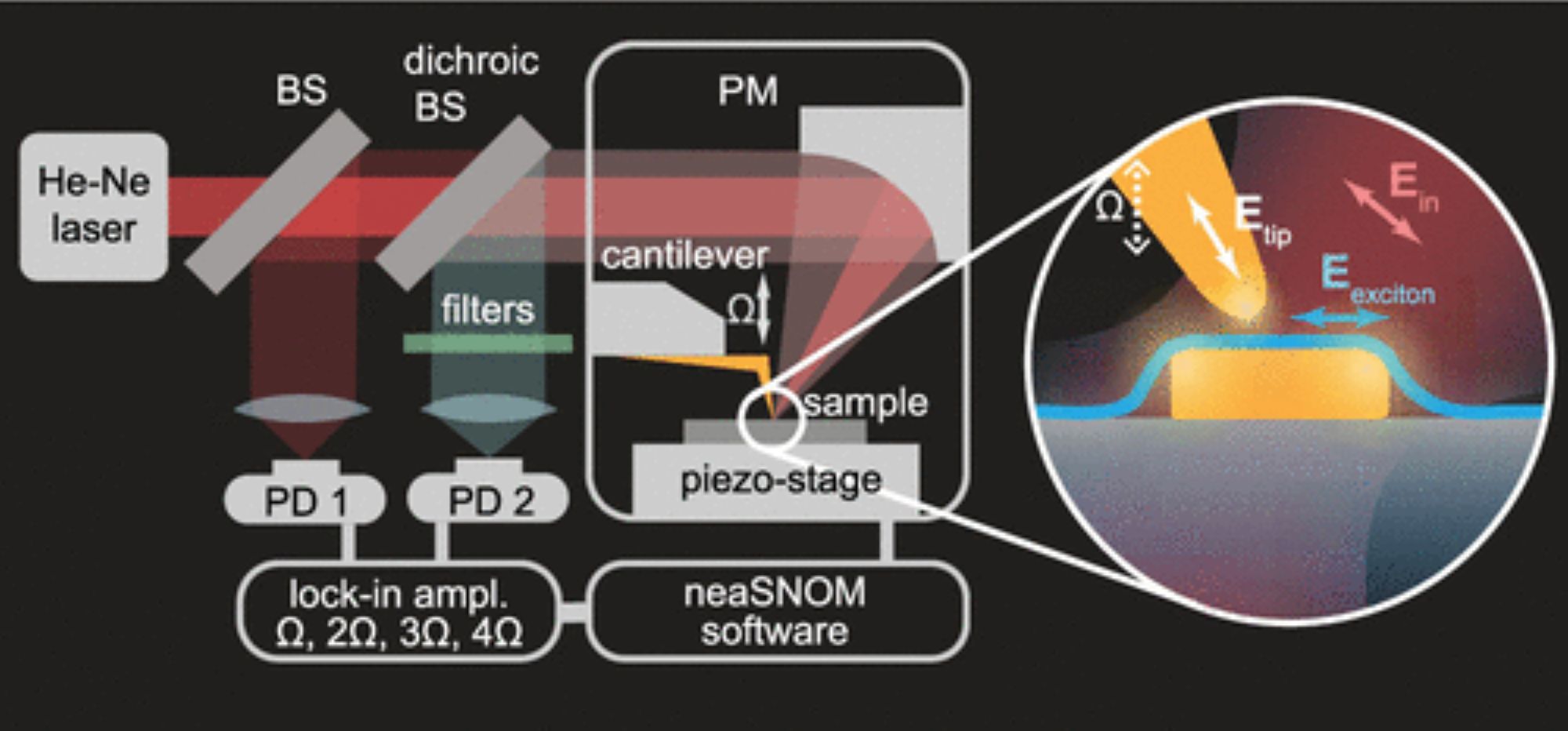Monolayer transition metal dichalcogenides, such as tungsten diselenide, have recently attracted considerable attention due to their reduced dielectric screening and direct bandgap, which result in high exciton binding energy and strong photoluminescence.*
The integration of monolayer transition metal dichalcogenides with plasmonic nanoparticles enhances their optoelectronic properties through localized surface plasmons and strong electromagnetic confinement. *
In the article “Enhanced Exciton–Plasmon Interaction Enabling Observation of Near-Field Photoluminescence in a WSe2–Gold Nanoparticle Hybrid System” Anastasia Romashkina, Sandhya Sushil, Angela I. Barreda, Zlata Fedorova, Fatemeh Abtahi, Nathan Doolaard, Zifei Zhang, Christian Helgert, Isabelle Staude, Falk Eilenberger, Thomas Pertsch and Bayarjargal N. Tugchin investigated the photoluminescence response of the hybrid system of monolayer tungsten diselenide and gold nanoparticle arrays through near-field mapping. *
Their study demonstrated a significant enhancement of the excitonic emission by the excited gold nanoparticles via near-field interaction. *
Anastasia Romashkina et al. examined the impact of exciton–plasmon-polariton coupling on the far-field response of the hybrid system. *
There, they observed the phenomenon of exciton-induced transparency, which indicates the intermediate coupling regime and helps resonantly enhance the light-matter interaction in monolayer tungsten diselenide.*
The second harmonic generation intensity from the hybrid system was shown to follow the linear spectral response of the hybrid system, thereby demonstrating the enhanced coupling between surface plasmons and excitons. Anastasia Romashkina et al.’s research offers insights into the impact of intermediate coupling on the optical properties of hybrid exciton–plasmon systems, which is crucial for the development of advanced nanophotonic devices. *
The authors investigate the near-field optical response of the hybrid system with a scattering-type near-field optical microscope (s-SNOM), which allows for high-resolution imaging of the evanescent fields of a sample by analyzing the light scattered by the AFM tip. Figure 2 in the cited article shows the scheme of the used setup. The s-SNOM is based on a tapping-mode atomic force microscope and uses a tip view AFM probes ( NANOSENSORS AdvancedTEC ATEC-NCAu) that oscillates above the sample with an amplitude of about 40 nm and a frequency of Ω = 275 kHz. *

Figure 2 from Anastasia Romashkina et al.2025, “Enhanced Exciton–Plasmon Interaction Enabling Observation of Near-Field Photoluminescence in a WSe2–Gold Nanoparticle Hybrid System”, Near-field optical microscope. Excitation and detection scheme in s-SNOM for the investigation of near-field photoluminescence.
The s-SNOM is based on a tapping-mode atomic force microscope and uses a gold coated NANOSENSORS AdvancedTECTM ATEC-NCAu tip-view AFM probe.
*Anastasia Romashkina, Sandhya Sushil, Angela I. Barreda, Zlata Fedorova, Fatemeh Abtahi, Nathan Doolaard, Zifei Zhang, Christian Helgert, Isabelle Staude, Falk Eilenberger, Thomas Pertsch and Bayarjargal N. Tugchin
Enhanced Exciton–Plasmon Interaction Enabling Observation of Near-Field Photoluminescence in a WSe2–Gold Nanoparticle Hybrid System
ACS Photonics 2025, XXXX, XXX, XXX-XXX
DOI: https://doi.org/10.1021/acsphotonics.4c01989
The article “Enhanced Exciton–Plasmon Interaction Enabling Observation of Near-Field Photoluminescence in a WSe2–Gold Nanoparticle Hybrid System” by Anastasia Romashkina, Sandhya Sushil, Angela I. Barreda, Zlata Fedorova, Fatemeh Abtahi, Nathan Doolaard, Zifei Zhang, Christian Helgert, Isabelle Staude, Falk Eilenberger, Thomas Pertsch and Bayarjargal N. Tugchin is licensed under a Creative Commons Attribution 4.0 International License, which permits use, sharing, adaptation, distribution and reproduction in any medium or format, as long as you give appropriate credit to the original author(s) and the source, provide a link to the Creative Commons license, and indicate if changes were made. The images or other third-party material in this article are included in the article’s Creative Commons license, unless indicated otherwise in a credit line to the material. If material is not included in the article’s Creative Commons license and your intended use is not permitted by statutory regulation or exceeds the permitted use, you will need to obtain permission directly from the copyright holder. To view a copy of this license, visit https://creativecommons.org/licenses/by/4.0/.